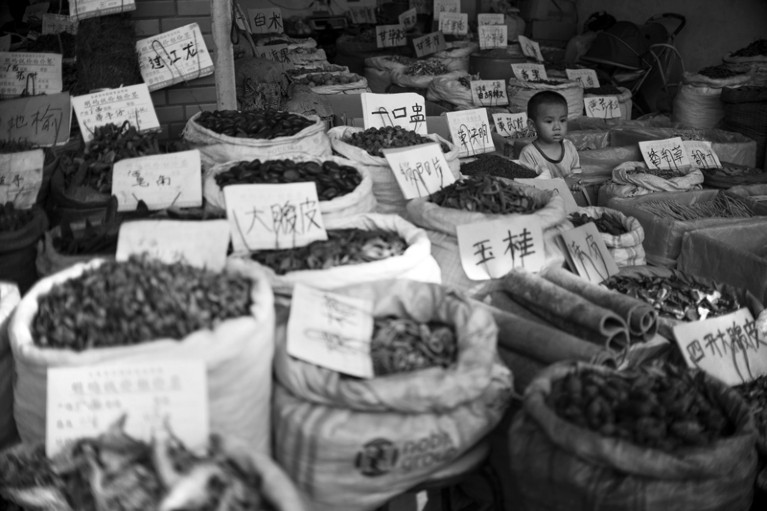
Changes to how China regulates traditional remedies are a backwards step.Credit: Johannes Eisele/AFP/Getty
In the 1990s, dozens of women who had taken Chinese herbs as part of a weight-loss programme ended up with kidney failure. Some died, and others became dependent on dialysis or transplants. Investigations blamed aristolochic acid, a natural ingredient of many traditional Chinese medicines (TCMs) that was quickly tied to other syndromes, including bladder cancer. Many countries across the world, from Japan to Canada, banned its use. China and the United States issued warnings, but allowed sales to continue. As use of the plant extract persists, so does the characterization of its dangers. In October, researchers published a report linking it to liver cancer (A. W. T. Ng et al. Sci. Transl. Med. 9, eaan6446; 2017).
All drugs carry a risk, and doctors who give out TCMs argue that poisoning by aristolochic acid is an unfortunate and rare side effect caused by misuse of the medicines. But such risks are supposed to be balanced by benefits, and the benefits in this case are far from clear.
Evidence-backed use of medicines demands tests for efficacy and safety in rigorous clinical trials, so that health-care officials can decide whether treatments should be used. China, however, is moving in the opposite direction. As we discuss in a News story this week, new draft guidelines would scrap clinical-testing requirements for those TCMs that are made according to classical recipes. Advocates of TCMs say that this will align China’s system with that of the United States, where supplements and herbal preparations need not pass the tests of the US Food and Drug Administration (FDA) before going on sale. That is true, but the US system is not one to emulate.
A 1994 US law lists such supplements as a separate category — neither food nor drug — and the FDA can try to ban them only if the agency proves them to be dangerous. The FDA has been playing catch-up ever since: even after fatal cases, all it can do is recommend that unsafe remedies be removed from the market. The law was a boon for the ballooning herbal and supplement business, but a major loss for science and for consumers, who often experienced adverse consequences.
There are major differences between the situation in the United States and in China. US companies, unlike their Chinese counterparts, are not supposed to say that herbal remedies cure disease. In China, by contrast, TCMs are often prescribed for specific diseases. The Chinese health ministry, for example, recommends an injectable herbal drug called Xiyanping for treating the H1N1 strain of influenza A (swine flu) and hand, foot and mouth disease. (In September, the China Food and Drug Administration pulled certain batches of Xiyanping from the shelves following reports of adverse effects.)
Demand for herbal remedies in China starts at the very top. President Xi Jinping has thrown his weight fully behind TCMs, which he says are crucial to the development of China’s health care. This is understandable: he has pledged to spread health care to everyone in the country, and Western health care — which currently dominates the market — is too expensive to roll out quickly. TCMs are also good business for Chinese companies, and sales at home and abroad have grown steadily over the past two decades. But political and economic expedience is no basis for health policy. Worse, the tighter embrace of TCMs from the country’s political elite is closing down debate among China’s medics and public over whether the remedies work.
The new approach stands in contrast to efforts over the past decade or so by the government and Chinese companies to demonstrate efficacy as part of a modern and international approach towards TCMs. Following this agenda, and rules to encourage a more evidence-based approach, the drug company Tasly in Tianjin finished a phase III controlled study of a Chinese herbal remedy for the heart condition chronic stable angina pectoris in December 2016. The company claims it is the world’s first compound Chinese herbal drug to have been shown to be safe and effective in “FDA-prescribed global multi-center phase-three clinical trials”.
Many doctors on the side of TCMs argue that the remedies cannot be tested because they have to be tailored on the basis of the doctor’s intuitive interpretation of patients’ needs, and are usually used in combination. That is not convincing. Just because standardized trials are difficult or expensive is not a reason to say they can’t be done — fast and cheap cannot be the goal of drug regulation. The world needs more such rigorous trials of herbal remedies, not a carte blanche for manufacturers to sell them to vulnerable patients.
The new regulations could have a bright side. Physicians hope that the rules will force manufacturers to be more careful about the composition of the drugs, which are often found to be adulterated. Ensuring the remedies are pure would be a positive step, but still wouldn’t answer the questions of whether they work and whether their effect is worth the risks. Such answers cannot be assumed. Hundreds of years of use in clinics that don’t standardize or analyse the clinical data are no match for blinded, controlled studies.

 China rolls back regulations for traditional medicine despite safety concerns
China rolls back regulations for traditional medicine despite safety concerns






